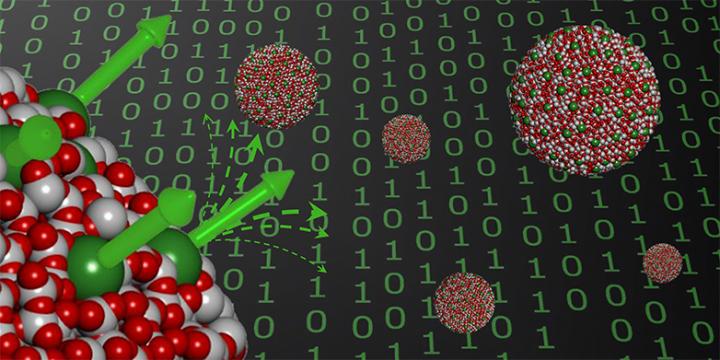Nanomagnets for future data storage

Dysprosium atoms (green) on the surface of nanoparticles can be magnetized in only one of two possible directions: "spin up" or "spin down." Credit: ETH Zurich / Université de Rennes
However, several obstacles still need to be overcome before single-molecule magnet data storage becomes a reality. Finding molecules that can store the magnetic information permanently and not just fleetingly is a challenge, and it is even more difficult to arrange these molecules on a solid surface to build data storage carriers. To address the latter problem, an international team of researchers led by chemists from ETH Zurich has now developed a new method that offers numerous advantages over other approaches.
Fusing atoms to the surface
Christophe Copéret, a professor at the Laboratory of Inorganic Chemistry at ETH Zurich, and his team developed a molecule with a dysprosium atom at its centre (dysprosium is a metal belonging to the rare-earth elements). This atom is surrounded by a molecular scaffold that serves as a vehicle. The scientists also developed a method for depositing such molecules on the surface of silica nanoparticles and fusing them by annealing at 400 degrees Celsius. The molecular structure used as a vehicle disintegrates in the process, yielding nanoparticles with dysprosium atoms well-dispersed at their surface. The scientists showed that these atoms can be magnetised and maintain their magnetic information.
The magnetisation process currently only works at around minus 270 degrees Celsius (near absolute zero), and the magnetisation can be maintained for up to one and a half minute. The scientists are therefore looking for methods that will allow the magnetisation to be stabilised at higher temperatures and for longer periods of time. They are also looking for ways to fuse atoms to a flat surface instead of to nanoparticles.
Simple preparation
One of the advantages of the new method is its simplicity. “Nanoparticles bonded with dysprosium can be made in any chemical laboratory. No cleanroom and complex equipment are required,” says Florian Allouche, a doctoral student in Copéret's group. In addition, the magnetisable nanoparticles can be stored at room temperature and re-utilized.
Other preparation methods include the direct deposition of individual atoms onto a surface, yet the materials obtained are only stable at very low temperatures mainly due to the agglomeration of these individual atoms. Alternatively, molecules with ideal magnetic properties can be deposited onto a surface, but this immobilization often negatively affects the structure and the magnetic properties of the final object.
###
For this research project, ETH scientists worked with colleagues from the Universities of Lyon and Rennes, Collège de France in Paris, Paul Scherrer Institute in Switzerland, and Berkeley National Laboratory in the USA.
Reference
Allouche F et al.: Magnetic Memory from Site Isolated Dy(III) on Silica Materials. ACS Central Science 2017, doi: 10.1021/acscentsci.7b00035
Media Contact
All latest news from the category: Physics and Astronomy
This area deals with the fundamental laws and building blocks of nature and how they interact, the properties and the behavior of matter, and research into space and time and their structures.
innovations-report provides in-depth reports and articles on subjects such as astrophysics, laser technologies, nuclear, quantum, particle and solid-state physics, nanotechnologies, planetary research and findings (Mars, Venus) and developments related to the Hubble Telescope.
Newest articles

Properties of new materials for microchips
… can now be measured well. Reseachers of Delft University of Technology demonstrated measuring performance properties of ultrathin silicon membranes. Making ever smaller and more powerful chips requires new ultrathin…

Floating solar’s potential
… to support sustainable development by addressing climate, water, and energy goals holistically. A new study published this week in Nature Energy raises the potential for floating solar photovoltaics (FPV)…

Skyrmions move at record speeds
… a step towards the computing of the future. An international research team led by scientists from the CNRS1 has discovered that the magnetic nanobubbles2 known as skyrmions can be…





















